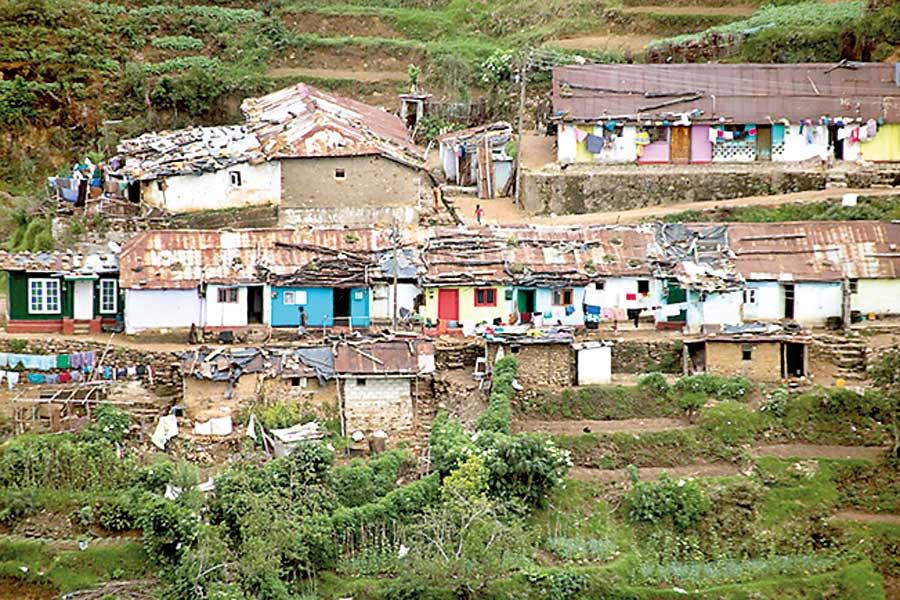21 Nov 2022 - {{hitsCtrl.values.hits}}

Ceylon tea' gave Sri Lanka the recognition in the world map, but the plantation workers are still languishing in their ages-old abode, known as line rooms and continue to be marginalised in education, community wellbeing and healthcare.
When our country collapses before our own eyes with one of the deepest crises in historical memory, from what vantage point should we analyse our predicament? Sri Lanka’s political economy over the last two centuries is anchored in the travails and strivings of Hill Country Tamils. Their sweat and blood, that began with the horrifying journey from South India two centuries ago as indentured labour to work in the coffee and later tea plantations, were central to building the country’s modern economy under British colonialism. However, their position in society, and for that matter even the writing of their history, was marginalised. And despite the great democratic and social welfare advances in Sri Lanka with universal suffrage in 1931 and a powerful legacy of free healthcare and education, the social, economic and political life of the Hill Country Tamil community is characterised by struggle amidst persistent crisis times.
vantage point should we analyse our predicament? Sri Lanka’s political economy over the last two centuries is anchored in the travails and strivings of Hill Country Tamils. Their sweat and blood, that began with the horrifying journey from South India two centuries ago as indentured labour to work in the coffee and later tea plantations, were central to building the country’s modern economy under British colonialism. However, their position in society, and for that matter even the writing of their history, was marginalised. And despite the great democratic and social welfare advances in Sri Lanka with universal suffrage in 1931 and a powerful legacy of free healthcare and education, the social, economic and political life of the Hill Country Tamil community is characterised by struggle amidst persistent crisis times.
The black hole of captive exploitation, the grave injustice of their disenfranchisement soon after Independence and continuing social exclusion remain an irredeemable blot on the history of the country. Furthermore, the political attacks on the Hill Country Tamils culminating in the repatriation negotiated between India and Sri Lanka marks a moment of tremendous irresponsibility, where a despicable colonial policy of forced migration was later repeated through an agreement of two postcolonial states.
Workers struggle and trade union initiatives marked the colonial decades of the Hill Country Tamils, as gruelling social and working conditions led to organising by progressive forces. However, a major blow to the emergent leftist politics in the plantations, which could have united their struggles with other working people in the country, was the denial of their citizenship rights. Eventually, the citizenship issue became their central struggle for decades until it was slowly addressed in subsequent decades. Over the last two decades, education and employment of the younger generation have emerged as the most important concerns of the community. Their youth who cannot find viable work and adequate incomes within the estates, migrate and work in low paying informal and service sectors in urban areas, including as domestic workers in affluent homes and as waiters and helpers in restaurants and shops. Meanwhile, the struggles in the estates continue for higher wages and better socio-economic conditions, particularly land for housing and cultivation, even as the longer-term future viability of the estates themselves are increasingly in question.
In recent years, in the lead up to the pandemic and continuing today, a formidable wage struggle for the estate workers has been met with broken promises from the state and the plantation companies. Indeed, pummelled by the disruptions and lockdowns with Covid-19 crisis where the migrant workers’ incomes were affected and provisioning on estates became difficult, the economic depression now underway in Sri Lanka is bound to devastate this community. As to how the state addresses the suffering of the Hill Country Tamils during the current crisis is going to become the litmus test of the future of social welfare in the country.
Continued displacement
My recent engagement with the tragic history of the Hill Country Tamil people brings out another hidden dimension – relating to a section of those who were not repatriated to India – of displacement to Northern Sri Lanka in the 1970s and early 1980s due to the evictions, mass violence and pogroms in the South of the country. The Tamil nationalist separatist project in the North was similar to the Sinhala Buddhist nationalist state-building project in the South in oppressing the Hill Country Tamil people; they were used as bonded labour for paddy cultivation, settled in borderlands to face the violence of the war and their children forcibly recruited to become cannon fodder for the LTTE’s military ambitions. From the ravages of war, the post-war political economy of the North provides few options for these long suffering people, and particularly their women who are burdened with both earning an income and provisioning and caring for their families.
 From their historical roots of wage-labouring as tea-pluckers in the estates and condemned to be landless in settlements lacking irrigation in the North, the younger generation of these women have few options. They find work in the recently formed garment factories in the North that squeezes out their youthful energies and spits them out. Others are involved in the dangerous work of landmine clearance. Furthermore, some find work in the militarised farms started by the state as part of controlling the war-torn population. None of these are permanent options, and amidst such precarious employment and exploitation, these women seek monthly incomes given the lack of land and other resources, and with little in the form of accumulation over the decades, to build their livelihoods. And even such gruelling work is only possible if a relative such as a mother or aunt can take care of their dependants and run the home.
From their historical roots of wage-labouring as tea-pluckers in the estates and condemned to be landless in settlements lacking irrigation in the North, the younger generation of these women have few options. They find work in the recently formed garment factories in the North that squeezes out their youthful energies and spits them out. Others are involved in the dangerous work of landmine clearance. Furthermore, some find work in the militarised farms started by the state as part of controlling the war-torn population. None of these are permanent options, and amidst such precarious employment and exploitation, these women seek monthly incomes given the lack of land and other resources, and with little in the form of accumulation over the decades, to build their livelihoods. And even such gruelling work is only possible if a relative such as a mother or aunt can take care of their dependants and run the home.
Amidst such exploitation and exclusion in the North, organising by community activists in some villages have led to advancement in gaining some land and control over social institutions such as community centres and co-operatives. However, their efforts are still lagging in organising the large mass of people, which is about asserting their distinct identity that has been repressed by the Tamil nationalists. The issues for progressive movements among these displaced communities are numerous from land, water, employment, educational advancement and women’s livelihoods, which all require resources, redistribution and community leadership.
Hope of a generation
The appalling situation of the Hill Country Tamils in the estates and their dispersed oppression in other parts of the country may imply a condition of utter dejection, but I draw inspiration from my many university students from the estates in their determination to rebuild their community. The focus of the community on education in recent decades has led to a younger generation that is more politically conscious and whose initiatives to advance education among the next generation and to study their own community’s predicament and seek solutions are admirable.
As we face the worst economic and political crisis during our post-colonial history, a reckoning with the historical challenges of marginalised communities is critical for finding ways of addressing the country’s woes. Indeed, the Hill Country Tamils’ predicament confronts us with the tremendous inequalities, oppressive exploitation and social exclusion that are some of the central aspects of the great suffering of working people underway with the current crisis in Sri Lanka. In this context, I am convinced that it is when the problems on the periphery are systematically addressed that the centre and the whole country are bound to be set on the sustainable path of progressive transformation.
Next year marks the 200th year anniversary of the forced migration of Hill Country Tamils to Sri Lanka, and it places a challenge before the intellectuals and scholars in Sri Lanka to reflect on the lost conscience of our country that has been complicit in the making of their tragic history. In the months and years ahead, I hope to research and write about the historical and contemporary issues of the Hill Country Tamils in collaboration with a younger generation of committed researchers.
19 Apr 2024 6 hours ago
19 Apr 2024 6 hours ago
19 Apr 2024 7 hours ago
19 Apr 2024 8 hours ago
19 Apr 2024 9 hours ago